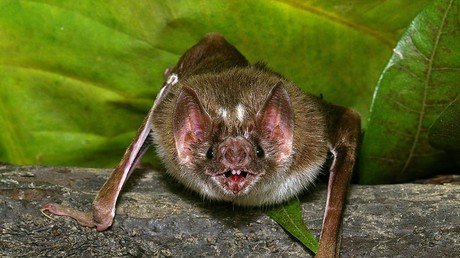Nosferbatu: Researchers reveal vampire bat’s genetic secrets

Scientists have cracked the mystery of how vampire bats can survive solely upon the blood of their victims. The nocturnal Latin American mammals are fascinating creatures, the study leader says.
The creepy nocturnal creatures are unique among mammals because they are the only ones that just drink blood. For the first time, scientists studying the vampire bat have mapped their complete genome, revealing that the winged mammal has a number of genetic traits that allow them to thrive on their unusual food source.
And they need these genetic advantages because mammals blood is not an ideal food source. For one, blood is low in nutrients and it can harbour blood-borne diseases. However, this is not a barrier for the vampire bat, as Lisandra Zepeda, the study’s lead author from the University of Copenhagen, explains.
“We decided to study this species because it has an ‘extreme’ diet, in the sense that it requires many adaptations in the organism to live on that,” Zepeda said. “Blood is a challenging dietary source since it provides very low levels of vitamins and carbs, and a lot of proteins, salts and waste products.”
The team compared the genome of the common vampire bat to it’s non-blood sucking relatives, and examined microbial DNA from its droppings to conclude that “there is a close evolutionary relationship between the gut microbiome and the genome of the vampire bat for adaptation to sanguivory (feeding exclusively on blood).”
They were also able to identify elements in the genome that allow the bats to defend against potentially lethal pathogens that lurk in their victim’s blood.
The common vampire bat is a nocturnal, cave-dwelling mammal that lives in Mexico, as well as Central and South America. They swoop down under cover of darkness to feed on the blood of livestock, landing beside them undetected. The bats then sink their razor-sharp teeth into their victims and use their elongated tongues to suck up the flowing blood.
Vampire bat's extreme blood-only diet 'a big evolutionary win', scientists sayhttps://t.co/ywlDpInx2Wpic.twitter.com/FgWMeCnlek
— AFP news agency (@AFP) 20 февраля 2018 г.
While this sounds rather horrifying, Zepeda thinks the bats get a bad rap.
“Yeah, they’re messed-up creatures, or amazing creatures, whatever you want to call them,” she said. “My personal feelings about them is that it’s too bad people demonize them like that. We should be amazed by them, not scared. They’re actually quite cute: abstract beauty. Sure, you don’t want them to bite your cows if you’re a farmer, but they were there way before you.”
The research was published on Monday in the journal Nature Ecology & Evolution.
Like this story? Share it with a friend!














